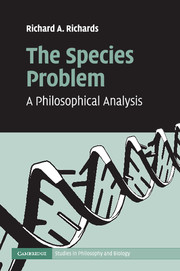Book contents
- Frontmatter
- Contents
- Acknowledgments
- 1 The species problem
- 2 The transformation of Aristotle
- 3 Linnaeus and the naturalists
- 4 Darwin and the proliferation of species concepts
- 5 The division of conceptual labor solution
- 6 Species and the metaphysics of evolution
- 7 Meaning, reference and conceptual change
- 8 Conclusion
- Bibliography
- Index
1 - The species problem
Published online by Cambridge University Press: 04 April 2011
- Frontmatter
- Contents
- Acknowledgments
- 1 The species problem
- 2 The transformation of Aristotle
- 3 Linnaeus and the naturalists
- 4 Darwin and the proliferation of species concepts
- 5 The division of conceptual labor solution
- 6 Species and the metaphysics of evolution
- 7 Meaning, reference and conceptual change
- 8 Conclusion
- Bibliography
- Index
Summary
THE SPECIES IDEA
Species are kinds of living things. This way of thinking about life seems to go back at least to Plato and Aristotle, who used the term eidos that meant in one sense, the appearance or form of a thing. For the naturalists who came after, species were also the relatively distinct groupings of individual organisms that were more or less similar in appearance and behavior, and that sometimes interbred. Since the development of a hierarchical taxonomy by Linnaeus in the eighteenth century, those organisms that had been grouped into species taxa were then grouped into more inclusive categories – genera, orders, classes, and ultimately kingdoms. Because species are the most basic groupings of organisms in this hierarchy, they are now usually regarded as the fundamental units of biodiversity. But for contemporary biologists steeped in evolutionary theory, species are much more. Darwinian evolution tells us that species are the things that are “born” in speciation from other species, change over time, produce new species, and ultimately “die” in extinction. Species are therefore also the fundamental units of evolution.
The idea of species has played a similarly significant role in philosophy. Philosophers have followed the tradition of Plato and Aristotle, as they understand it, and have treated those groups of organisms we identify as species as natural kinds with essences.
- Type
- Chapter
- Information
- The Species ProblemA Philosophical Analysis, pp. 1 - 16Publisher: Cambridge University PressPrint publication year: 2010
- 1
- Cited by



